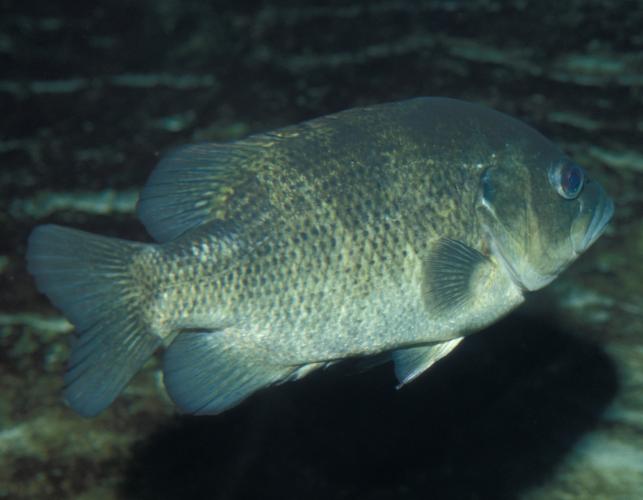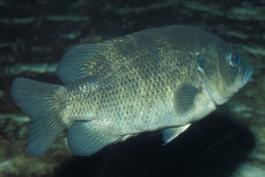Ankle-deep in a clear, Ozark stream, a wading fisherman pauses and sits on a small boulder to empty his shoes of creek gravel. In response to the angler's presence, a small crayfish pokes its head from under a nearby rock. The fisherman reaches down and grabs the crustacean in one swift move. He then places it in his bait bucket, which holds others caught earlier.
Two hundred yards downstream, the angler finds a cluster of boulders in flowing water, 5-feet deep, with the roots of a flood-downed tree lodged among them. Wading out to the cover, the fisherman hooks a crayfish by the tail and allows it to swim into a crevice formed where the boulder meets the tree roots.
A thick-loined panfish darts out and sucks in the crayfish.
A quick snap of the fisherman's wrist puts a bend in the pole, and the angler brings to hand the first rock bass of the day. An hour later he leaves the cover and heads back upstream with 10 nice rock bass trailing behind him on a stringer.
Rock bass are common in the streams of the Missouri Ozarks. They are exciting to catch and, as table fare, are sweet and tender. Despite these attributes, relatively few stream anglers devote much attention to catching rock bass. Why? Because rock bass share quarters with smallmouth bass, whose spectacular fighting ability and larger size give it first billing.
Stream fishermen who concentrate solely on smallmouth are missing a lot of fun. Keeper-size smallmouth bass are difficult to catch, and most anglers end up releasing them to protect this popular game fish.
Not so with rock bass. You can creel this panfish with a clear conscience. Limits are liberal, and the fish aren't very spooky. Wade or float out to some good structure, offer bait or jig, and chances are good that a rock bass will take it.
Rock bass hit with incredible speed. They strike in a silt-stirring rush, then quickly turn and disappear back into cover. Watching this happen practically at your feet is pure fishing excitement! You'll also appreciate how hard a rock bass can pull against your fishing rod as they shoot from cover, swimming on their sides, shaking and tugging.
Brought to hand, rock bass are pleasing to the eye. They are the chameleons of the sunfish family. They usually sport a black hue with just a hint of tan on their sides. Brought into full light, however, they quickly turn brassy gold, blotched with black.
Rock bass classification has changed in the last few years. Before 1980, only one species of rock bass was recognized in the Ozarks: the northern rock bass (Ambloplites rupestris). Now biologists recognize three: the northern rock bass, the southern rock bass (Ambloplites ariommus), and the Ozark rock bass (Ambloplites constellatus). All three species closely resemble one another, and distinguishing them requires careful counts of fin rays and body scales.
Perhaps the best clue to species is what waters the fish call home. If you catch rock bass in the rivers and tributaries feeding Table Rock and Bull Shoals lakes and Lake Taneycomo in the south-central part of the state, you are catching Ozark rock bass. Rock bass caught in the Meramec and Missouri river drainages are the northern species. This species also occurs in the Spring and Elk river systems of southwest Missouri by way of transplanted populations. Southern rock bass thrive throughout the rest of Missouri's southeastern Ozark streams and creeks.
Most rock bass run from 6 to 10 inches long and weigh less than 8 ounces. Anything over 9 inches is a fish to admire; a 10-inch rock bass will earn you a Master Angler patch in Missouri. The Missouri state record, caught in 1968 in the Big Piney River, weighed 2 pounds, 12 ounces and measured 17 inches. Most rock bass are bantam-weights, but some are big enough and feisty enough to break your line.
Rock bass typically spend the daylight hours within the nooks and crannies of rootwads and undercut rocks in running water between 3 and 12 feet deep, so you must present a bait or lure directly in such places. The best approach is to wade or float out to promising cover and jig with a bait or lure.
Although they typically seek cover, rock bass venture into open water from the mid-April to early July breeding season. Like all sunfish, male rock bass fan out a circular bed where they protect eggs after spawning.
Though the beds are not concentrated like those of bluegills, male rock bass on spawning beds are vulnerable to predation. If you remove a male rock bass from its nest, smaller sunfish quickly rush in and consume the eggs. During the spawn it's best to leave nesting males alone and limit fishing for rock bass to catch and release.
The spawn is over when you no longer see male rock bass guarding nests, and the waters teem with the black fry of rock bass and their smallmouth cousins. Then it's time to catch and keep, if you wish.
You can use a smorgasbord of bait choices to catch rock bass. They'll take just about any live bait they can get in their mouth, including minnows, worms, crayfish, hellgrammites, crickets and grasshoppers. Small crayfish will catch rock bass in almost all situations. A 2-inch crayfish hooked through the tip of the tail with a No. 6 hook and poked into good cover will usually draw a strike.
The best artificial lures for rock bass include small jigs or grubs. Actually, almost any small- to medium-size lure will do, as long as it does not hang up often in heavy cover.
A stringerful of rock bass represents a panful of the finest eating fish to be had anywhere in the state, but it's important to handle them properly for best results. All fish flesh is delicate. Once fish die, their muscles quickly break down, affecting flavor and texture. Therefore, it's best to keep fish alive until you are ready to clean them. If a rock bass is hooked deeply in the throat, cut the line and leave the hook. Attempting to remove the hook will likely kill the fish. Float fishing anglers can kill the fish and put them on ice in a cooler to help preserve their flavor.
Despite their meaty flanks, rock bass yield small fillets compared to those of larger fish. Rock bass fillets fry quickly and, like any small fillets, if cooked too long become tough and hard. To avoid overcooking, it's advisable to deep fry all rock bass. This eliminates guess work. When the fillets float in hot oil-usually within minutes-they are done.
The Conservation Department is presently conducting research to determine if rock bass catch rates and size can be improved by tweaking regulations. Since Jan. 1, 1995, special regulations have been in place along a 10.6-mile stretch of the Big Piney River between Highway 17 Bridge and Sand Shoals Bridge (linking Routes E and AA). These regulations include a 9-inch minimum length limit and a creel limit of nine fish per day.
Michael Roell, an MDC fisheries biologist in charge of the rock bass project, said research data will not be complete for a few more years, but what we learn from the study will provide the basis for other rock bass regulations in the Missouri Ozarks.
Current statewide regulations allow anglers to keep 15 rock bass per day with no minimum length requirement.


And More...
This Issue's Staff
Managing Editor - Bryan Hendricks
Art Editor - Dickson Stauffer
Artist - Dave Besenger
Artist - Mark Raithel
Photographer - Jim Rathert
Photographer - Cliff White
Staff Writer - Jim Low
Staff Writer - Joan McKee
Composition - Libby Bode Block
Circulation - Bertha Bainer






















